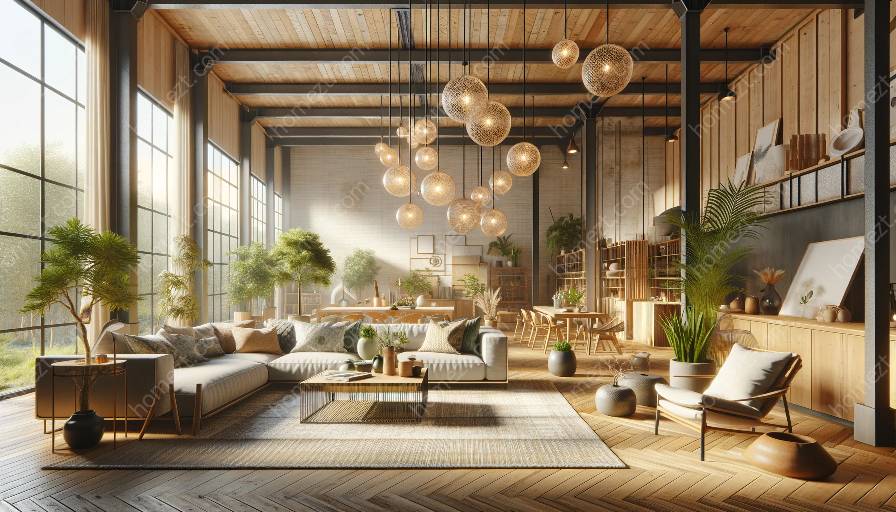As the world becomes more eco-conscious, sustainable and eco-friendly design principles are gaining traction in the interior design and styling industry. One of the key aspects of sustainable interior design is the use of eco-friendly materials, which not only reduce the environmental impact but also contribute to creating aesthetically pleasing and stylish spaces.
The Importance of Eco-Friendly Materials in Interior Design
Eco-friendly materials are sourced, produced, and utilized in a manner that has a minimal negative impact on the environment. Incorporating such materials into interior design is crucial for reducing the carbon footprint and promoting sustainability. By using eco-friendly materials, interior designers can contribute to preserving natural resources, minimizing waste, and enhancing indoor air quality, creating healthier living environments for both the occupants and the planet.
Types of Eco-Friendly Materials for Interior Design and Styling
There is a wide range of eco-friendly materials that can be incorporated into interior design and styling projects. These materials offer sustainable and stylish solutions for creating beautiful spaces while minimizing the ecological impact. Some popular eco-friendly materials include:
- Reclaimed Wood: Salvaged wood from old structures or furniture, which adds character and warmth to interior spaces while reducing the demand for new timber.
- Bamboo: A fast-growing and renewable material that can be utilized for flooring, furniture, and decorative elements, offering a unique and sustainable aesthetic.
- Cork: A sustainable and versatile material often used for flooring, wall coverings, and accessories, known for its natural insulation properties and sound absorption.
- Recycled Glass: Glass sourced from recycled materials, ideal for creating decorative elements and surfaces, adding a touch of elegance and sustainability to interior design.
- Recycled Metal: Salvaged metal that can be repurposed for furniture, lighting, and architectural details, contributing to an industrial chic and sustainable design approach.
- Natural Fabrics: Organic cotton, linen, hemp, and other plant-based textiles that offer comfort, durability, and biodegradability, providing sustainable upholstery and soft furnishings options.
- Low-VOC Paints: Paints with low volatile organic compound content, minimizing harmful emissions and promoting healthier indoor air quality, ideal for achieving vibrant and eco-friendly interior color schemes.
Innovative Applications of Eco-Friendly Materials
Interior designers and stylists are continuously exploring innovative ways to integrate eco-friendly materials into their projects. Some inspiring applications of such materials include:
- Modular Eco-friendly Furniture: Designing modular and adaptable furniture systems using sustainable materials, offering flexibility and versatility in interior layouts and configurations.
- Sustainable Lighting Fixtures: Creating eco-friendly lighting solutions using recycled and energy-efficient materials to illuminate interiors with style and sustainability.
- Biophilic Design Elements: Introducing nature-inspired elements and living materials such as moss walls, green roofs, and vertical gardens, connecting occupants with nature and promoting wellbeing in sustainable ways.
- Upcycled Accents: Incorporating upcycled or repurposed elements, such as salvaged doors, windows, and architectural features, to add unique character and sustainability to interior spaces.
Sustainable and Eco-Friendly Interior Design Principles
When incorporating eco-friendly materials into interior design and styling, it is essential to embrace sustainable principles that go beyond material selection. These principles include:
- Energy Efficiency: Designing spaces to maximize natural light, utilize energy-efficient appliances, and incorporate insulation and thermal efficiency solutions to reduce energy consumption.
- Water Conservation: Implementing water-saving fixtures, recycling water, and utilizing sustainable irrigation systems to promote responsible water usage within interior environments.
- Waste Reduction: Embracing practices such as recycling, composting, and utilizing durable and long-lasting materials to minimize waste generation and promote a circular economy approach.
- Biophilic Design: Integrating nature-inspired elements and creating connections with natural environments to enhance occupant wellbeing and foster sustainable design solutions.
- Cradle-to-Cradle Design: Embracing the concept of designing products and materials with the intention of reusing, recycling, or biodegrading them at the end of their lifecycle to minimize environmental impact.
Realizing the Vision of Sustainable and Stylish Spaces
By integrating eco-friendly materials and embracing sustainable design principles, interior designers and stylists have the opportunity to realize the vision of sustainable and stylish spaces. Collaborating with like-minded manufacturers, artisans, and clients, they can create interiors that are not only visually captivating but also environmentally responsible and socially conscious.
Ultimately, the incorporation of eco-friendly materials into interior design and styling is a testament to the industry's commitment to fostering a more sustainable and eco-conscious future. Through thoughtful material choices, innovative applications, and adherence to sustainable design principles, interior designers can continue to drive the evolution of eco-friendly interior design, shaping spaces that harmonize with nature and contribute to the wellbeing of both the inhabitants and the planet.


























